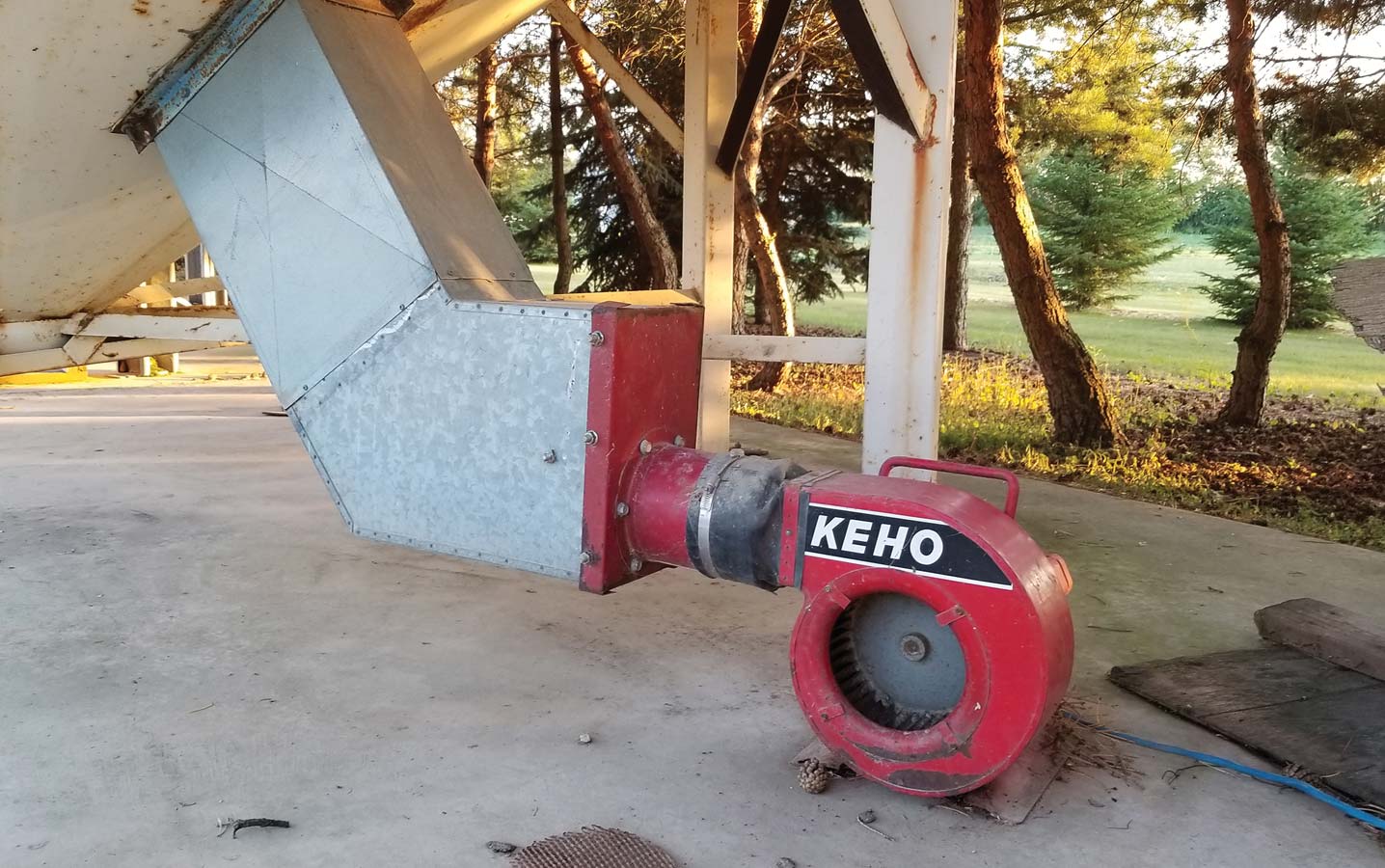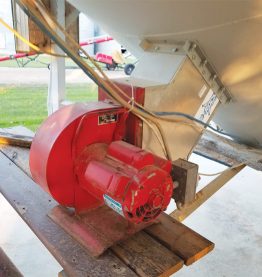On-off strategies for canola aeration
For years, the only topics that created much buzz in the commodity storage world was either the unfortunate situation of a large bin going up in smoke or a cool new technology that allowed monitoring stored grain to become a more seamless task.
Neither is insignificant, but the point is, while crop pest and genetic research can grab the headlines, storage research rarely does. That was until we heard the theory of night-time drying. Something new after all these years of managing our bins the same.
The research, started by the late Guy Lafond at the Indian Head Agricultural Research Foundation and carried on by Ron Palmer, professor of engineering at the University of Regina, monitored moisture movement in and out of the bin and showed that with continuous fan operation, the largest amount of moist air was expelled at night. It also found that we are often accomplishing warming of the bulk during the day and cooling at night.
Perhaps from a slight oversimplification of these findings came the “yard-light” rule: Switch the fans on at dark and off again in the morning. This method and the prospect of reducing energy costs has intrigued a lot
of producers.
Clearly, we can accomplish cooling with the yard-light rule, but the big question is, can cool, dry air successfully get our canola to the safe storage target of eight per cent moisture content (MC)?
Cool air has low capacity to dry
If time or resources aren’t available for close monitoring, or if there is concern with execution of fan control strategies, there is nothing wrong with continuous fan operation.
To try to get a handle on that question, the author spoke with Fuji Jian, an assistant professor in biosystems engineering at the University of Manitoba, and the lead or co-investigator of many storage research projects.
First off, relative humidity (RH) is important to understand. RH is the per cent saturation of air with water vapour. RH does not tell you the air’s moisture-holding capacity, which is greatly affected by temperature. At the same relative humidity, warm air will contain vastly more water vapour than cool air.
For instance, one kilogram (kg) of air at 35ºC has a moisture-holding capacity of approximately 37 grams (g) whereas one kg of air at 10ºC has a moisture-holding capacity of 8g. At 60 per cent RH, the 35ºC air has the ability to “take in” 15g before saturation while the 10ºC air can only take in 3g.
This seems relatively simple. If the air can take in a lot of moisture, it must be good to dry with. What complicates this greatly is that we cannot just think of ambient conditions in isolation; the grain condition itself has an effect on that incoming air.
Consider what happens when we blow warm air onto a cool bulk. Initially, the air will be cooled upon hitting the grain – potentially reaching dew point and causing condensation if the grain is wet enough. In this case, the drying ability may be lessened (as the cooled air has less water-holding capacity) until the fans have run long enough to consistently warm up the whole bulk.
Jian explained that during drying, two processes occur that both require energy (which can be provided in the form of heat): water evaporation on the surface or inside of the grain kernels and water migration from the inside to the outside of the grain kernel. Required energy can come from the grain itself, such as grain with high temperature, or from high-temperature air. Without energy, grain cannot be dried.
Think of the scenario of a warm day of harvesting followed by a cool night. When blowing cool night air into warm grain, initially the grain provides energy for drying because the air is cool. In this case, “drying cannot last long because the grain will quickly be cooled down to the air temperature,” Jian says. Drying will likely occur, albeit temporarily, he adds, if air RH is less than 70 per cent and air temperature is less than the grain temperature.
How much moisture can we remove in the cooling process? Based on energy conservation calculations and testing, Jian says grain can lose about 0.8 to 1.0 per cent moisture content (MC) if grain temperature drops 30°C, canola moisture is above 12 per cent and this process happens at above 0°C.
Temperature is important also for the rate of drying or rewetting, as it has a large influence on the diffusion of water across or through surfaces – an important process in lowering moisture within seeds. Lower temperatures mean much slower diffusion and eventual drying.
As we can see in Table 1, drying time increases fairly dramatically as the air temperature decreases. So, although drying can be done with cooler air, it requires a lot of patience.
In speaking with Jian, it became apparent that conditions for drying are too complex to give a definitive yes or no answer on the “yard-light” rule. The science shows obvious, although maybe somewhat limited, parameters where it will work.
EMC tables might help
Generally speaking, grain will absorb water if the air has a higher moisture content than the grain itself. And grain will lose water if the air has a lower moisture content than the grain itself. This is related to the theory of equilibrium moisture content (EMC), which asserts that the grain and the air will eventually equilibrate to a certain moisture content or relative humidity. EMC is specific to each commodity and air condition.
Jian encourages producers to use EMC charts (See Table 2) to understand when air can accomplish drying and when it cannot. This could then be used as a potential fan control strategy: fan on when EMC is less than the current MC of the grain, fan off when the EMC is greater than the MC of the grain. Some technologies already use this theory in fan control systems.
| Air RH (%) | Air temperature (°C) | |||
|---|---|---|---|---|
| 35 | 30 | 25 | 21 | |
| 70 | 13.5 | 19.3 | 38.2 | 187.5 |
| 60 | 13.4 | 19.3 | 38.1 | 187.0 |
| 50 | 13.3 | 19.2 | 38.0 | 186.6 |
| 40 | 13.2 | 19.2 | 37.9 | 186.1 |
| 30 | 13.2 | 19.1 | 37.8 | 185.7 |
| 20 | 13.1 | 19.1 | 37.7 | 185.2 |
For more on canola storage, read the chapter at canolaencyclopedia.ca and the articles at canolawatch.org.
(Assumptions: density of the canola = 52 lb./bu., 1.0 cfm/bu air flow rate, the canola temperature is 20°C)
Note: the accuracy of the drying time ranges from 50 to 80 per cent.
The trend remains correct.

The information regarding the canola EMC chart was found in the following paper: Equilibrium Relative Humidity-Moisture Content of Rapeseed (Canola) from
5°C to 25°C. S. Sokhansanj, W. Zhijie, D. Jayas, T. Kameoka (1986)
There are limitations to these charts though.
Joy Agnew, researcher with the Prairie Agricultural Research Institute, says they were developed many years ago using varieties that likely had very different oil content and seed size than current varieties. “It’s unclear how much these changes would affect the EMC values.”
Agnew mentions another limitation: the EMC charts do not account for grain’s effect on the incoming air. “If a farmer was to turn on a fan only for a few hours when the air is warm and the grain is cold, that’s a problem.”
To be successful with manual fan control using the EMC charts, the user needs to understand this relationship, as well as the fact that temperature has a large role to play in the rate of drying or rewetting – as demonstrated in Table 1.
Another possible concern with using EMC charts is the fear of “crusting” in the bin. This is the idea that if fans are shut off before the drying front goes all the way through the bulk, a crusted layer will form that would impede airflow once the fans were turned on again. Jian says the amount of crusting, or whether it occurs at all, will depend on the canola condition, weather condition and fan run time.
“Generally speaking, if the canola has high temperature (>30°C) and higher MC (>14 per cent) at the top of the drying front, crusting might occur if the fan is stopped for more than three days,” Jian says.
Although he has no lab data to back it up at this point, he suggests from experience that if canola’s moisture content is less than 12 per cent and the temperature less than 25°C at the top of the drying front, and the fan is stopped for less than a week, crusting will not happen. (Note: As air moves through stored grain, it picks up expelled moisture and concentrates it above the front. Therefore, grain above the drying front will have much higher MC than what the grain had when originally binned. Air above the front will also be warmer.)
Keep the fan running
Agnew summarized the idea of intermittent fan control to say, “As long as grain isn’t hot or really tough, it makes more sense to only run the fan when the air has capacity to dry. But if grain is hot and tough (or freshly harvested), run the fan regardless.”
Jian seems to agree. “From the view of safe storage, the fan should not be stopped if the initial MC and temperature of the canola are high,” he says.
Rewetting risk
One issue with constant fan operation is the fear of “rewetting” the grain, which is counterproductive and potentially wasteful. Continuous fan operation, which has long been advocated for by storage researchers and extension specialists, runs the risk of some degree of rewetting on days when the air’s EMC is greater than the grain’s MC.
How readily does grain take on moisture? If air has a very high EMC and grain has low moisture content, rewetting can happen faster than drying, Jian says. In most scenarios, it is a much quicker process to re-dry grain that has once been dried throughout the kernel already, as the rewetting event is usually just surface moisture that accumulates through condensation. However, the more time that elapses after the initial rewetting event, the less true this statement becomes.
In conclusion, it is apparent that straying from the traditional way of drying comes with challenges. But so long as careful and regular monitoring is done, particularly shortly after binning, strategies such as manual fan control or night time drying when conditions allow can be successful.
If time or resources aren’t available for close monitoring, or if there is concern with execution of fan control strategies, there is nothing wrong with continuous fan operation. Air blowing will serve to break up any hot spots and prevent moisture migration, even if the air is not necessarily accomplishing drying 100 per cent of the time.






